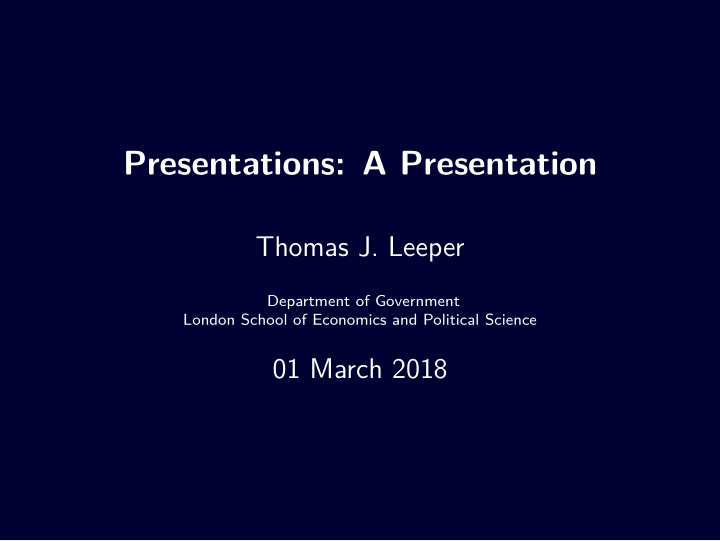



Presentations: A Presentation Thomas J. Leeper Department of Government London School of Economics and Political Science 01 March 2018
Presenting � = talking! Presenting � = reading!
Basics
Presentations in a Nutshell 1. Know your audience, why you’re talking, and why they’re listening 2. Convey one and only one main point 3. Less is almost always more
Structure of an Academic Talk 1. What are you doing? And why should we care? 2. What do we already know? (Briefly!) 3. What do you think is going on? 4. What did you do? 5. What did you find? And why should we care?
Structure of a Proposal Talk 1. What are you doing? And why should we care? 2. What do we already know? (Briefly!) 3. What do you think is going on? 4. What do you plan to do? 5. What do you want feedback on?
Slides
Slides are something you produce for ideas you can’t express in spoken word! Or, they are to emphasize something you are doing as part of the presentation.
Why is this picture here?
Why is this picture here? Also, the resolution is too low
This is a terrible slide ◮ The bullet points are not really bullet points but extremely long essay-style sentences that no is going to read. The only reason they’re here is probably because the presenter thought they might read them out loud from the overhead because they didn’t practice and therefore thought they would forget what they were supposed to talk about. ◮ To fit all of that text on the slide, the font size is tiny. It’s unreadable in fact even at a short distance. What was the presenter thinking? ◮ What’s the point of this slide ultimately? Is the content on the slide important — something the audience actually needs to see? Or is the content of this slide here just to reminder the presenter of something? If it’s the former, it’s failing. If it’s the latter, it shouldn’t be a slide at all.
Keep it simple
Keep it simple Use contrasting color and font for emphasis.
How to Use Slides ◮ Write your presentation. Then make slides.
How to Use Slides ◮ Write your presentation. Then make slides. ◮ Keep slides as simple as possible ◮ Use handouts if necessary
How to Use Slides ◮ Write your presentation. Then make slides. ◮ Keep slides as simple as possible ◮ Use handouts if necessary ◮ Use large, consistently sized sans-serif fonts
How to Use Slides ◮ Write your presentation. Then make slides. ◮ Keep slides as simple as possible ◮ Use handouts if necessary ◮ Use large, consistently sized sans-serif fonts ◮ Use clear, high-contrast colors
How to Use Slides ◮ Write your presentation. Then make slides. ◮ Keep slides as simple as possible ◮ Use handouts if necessary ◮ Use large, consistently sized sans-serif fonts ◮ Use clear, high-contrast colors ◮ Use images to convey ideas, not decoration
Avoiding Mistakes
Biggest Mistakes ◮ Reading from slides ◮ Reading from bad slides ◮ Slide content that you don’t talk about ◮ Speaking too fast ◮ Speaking too quietly ◮ Moving around without purpose
Avoiding Mistakes I
Avoiding Mistakes I ◮ Practice
Avoiding Mistakes I ◮ Practice ◮ Practice
Avoiding Mistakes I ◮ Practice ◮ Practice ◮ Practice
Avoiding Mistakes I ◮ Practice ◮ Practice ◮ Practice ◮ Practice
Avoiding Mistakes I ◮ Practice ◮ Practice ◮ Practice ◮ Practice ◮ Practice
Avoiding Mistakes II
Avoiding Mistakes II ◮ Know your time limit. Max 1 slide per minute.
Avoiding Mistakes II ◮ Know your time limit. Max 1 slide per minute. ◮ Stop talking when time is up. Don’t talk faster.
Avoiding Mistakes II ◮ Know your time limit. Max 1 slide per minute. ◮ Stop talking when time is up. Don’t talk faster. ◮ You don’t need to say all your thoughts.
Avoiding Mistakes II ◮ Know your time limit. Max 1 slide per minute. ◮ Stop talking when time is up. Don’t talk faster. ◮ You don’t need to say all your thoughts. ◮ Great artists steal.
Avoiding Mistakes III Warm up your voice!
Avoiding Mistakes III Warm up your voice! uh — eh — ee — oo — uu
Avoiding Mistakes III Warm up your voice! To sit in solemn silence in a dull dark dock In a pestilential prison with a life long lock Awaiting the sensation of a short sharp shock From a cheap and chippy chopper on a big black block
Avoiding Mistakes III Warm up your voice! Betty Botter bought some butter, but she said ‘This butter’s bitter.’ ‘If I put it in my batter, it will make my batter bitter.’ So, she bought some better butter, better than the bitter butter. When she put it in her batter, the butter made her batter better.
Are Political Orientation Genetically Transmitted?
Causes of Opinion Formation Political scientists have identified many causes of opinion formation: ◮ Socialization ◮ Mass media ◮ Values and predispositions Why haven’t we thought about genetics?
Twin Studies ◮ Gather phenotype data on pairs of twins ◮ Monozygotic ◮ Dizygotic ◮ Partition outcome variance into three components ◮ Heritability ◮ Shared environment ◮ Unshared environment
Our Data ◮ Data: ◮ Survey of pairs MZ and DZ twins (US) ◮ Supplemental data from Australia ◮ Outcome ◮ Wilson-Patterson Attitude Inventory ◮ 50 items measuring liberal–conservative ideology ◮ Method of analysis ◮ Standard twin study design ◮ Estimate heritability of each issue-specific phenotype and overall ideology
Desired Feedback ◮ What literature should we situate this in? ◮ Application of behavioural genetics in new domain ◮ A critique of the political socialization literature ◮ How can we improve our measure of political orientations? ◮ How can we avoid being seen as advancing a eugenics-type argument?
Recommend
More recommend